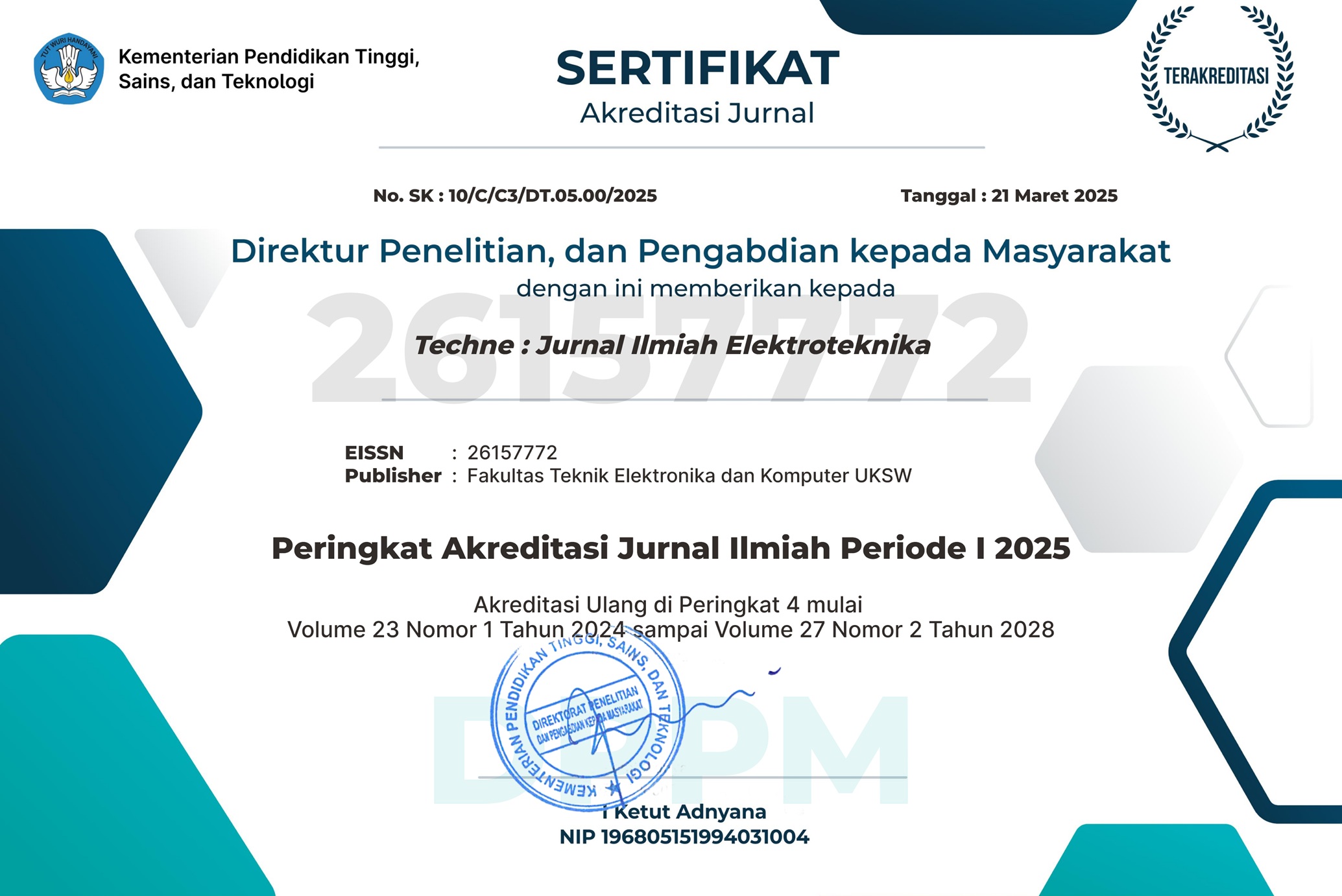Sistem Kendali Level Ketinggian Air Berbasis Fuzzy Control Menggunakan Simulink
DOI:
https://doi.org/10.31358/techne.v21i1.287Keywords:
Fuzzy, Level Sensor, PLC, OPC Software, Simulink, DC Servo MotorAbstract
Today's technology shows very significant developments in automation systems. Filling water in a tank is a process that is widely used in the oil industry. The process of filling and draining water in a closed water tank will raise difficulty for the operator to control the water level in the tank. Therefore, we will create a system to control the water level using a fuzzy controller. To get the value of fuzzification from the difference in the value of the set point and defuzzification connected to the motor pump. Fuzzy design system was obtained by making methods, fuzzification, defuzzification, and rules. The use of ultrasonic sensors during the experiment caused a spike in value because the ultrasonic sensor had not detected water but had no significant effect on the response to altitude levels. When the valve is opened, the controller has an effect on the resulting response. The more the valve is opened, the worse the response will be but the system remains stable. The fuzzy output will be connected to the PLC which will be connected to the Kepserver and tank to regulate the flow rate to the tank. Matlab is connected with PLC devices using Kepserver. The best performance is found in the 2× reduction valve opening response test with a fuzzification range of 8000-24000 while the performance value of time rise is 66.458 s, settling time is 110 s, steady state error is -2%, and overshoot is 9%.
Downloads
References
M. Iqbal, “Simulation of Water Level Control in a Tank Using Fuzzy Logic in Matlab.,” Int. J. Eng. Comput. Sci., vol. 6, no. 5, pp. 21303–21306, 2017, doi: 10.18535/ijecs/v6i5.18.
B. O. Omijeh, “Simulated Design of Water Level Control System,” Comput. Eng. Intell. Syst., vol. 6, no. 1, pp. 30–40, 2015.
C. Wida, “Implementasi Fuzzy Logic Controller untuk Pengendalian Level Air,” Elektran, vol. 2, no. 1, pp. 1–5, 2012.
B. Warsito, A. Rusgiyono, and M. A. Amirillah, “Pemodelan General Regression Neural Network Untuk Prediksi Tingkat Pencemaran Udara Kota Semarang,” Media Stat., vol. 1, no. 1, 2012, doi: 10.14710/medstat.1.1.43-51.
J. Dabney and T. L. Harman, “Mastering SIMULINK 2,” in MATLAB curriculum series, 1998, pp. xvii, 345 p.
I. N. Agiska, E. S. Budi, and H. K. Safitri, “Sistem Kendali PI Menggunakan PLC CP1H dan HMI pada Aplikasi Miniplant Pemanas Air,” Elkolind, vol. 8, no. 9, 2021, doi: DOI: http://dx.doi.org/10.33795/elkolind.v8i1.
R. D. Raharjo, “DESAIN DAN IMPLEMENTASI KONTROLER PID GAIN SCHEDULING UNTUK SISTEM PENGATURAN PROSES LEVEL PADA PROCESS CONTROL TECHNOLOGY-100,” Elkolind, vol. 53, no. 9, pp. 1689–1699, 2013.
A. Pudin, “PENGENDALIAN LEVEL CAIRAN TANGKI BERBSIS MATLAB, Jurnal Teknik,” Teknik Energi, vol. 3, no. April, pp. 199–203, 2013.
J. Tarigan and M. Bukit, “Perancangan alat pendeteksi banjir mandiri berbasis sms menggunakan sensor ultrasonik dan arduino uno,” Teknik Mesin, vol. 4, no. 1, pp. 1–7, 2021.
L. Dika and S. Pradana, “Perancanagan Monitoring RPM Motor Induksi Tiga Fasa pada Penggerak Generator,” Pendidikan Teknik Elektro, vol. 06, no. September, pp. 44–52, 2021.
D. Supriadi, “Rancang Bangun Sistem Pengendalian Ketinggian Air Menggunakan Sensor Ultrasonic Berbasis PLC ( Programmable Logic Controller ),” TEDC, vol. 9, no. 3, pp. 192–196, 2015.
Downloads
Published
How to Cite
Issue
Section
License
Copyright (c) 2022 Fani Kurniawan, Yulian Zetta Maulana, Risa Farrid Christianti

This work is licensed under a Creative Commons Attribution-NonCommercial-ShareAlike 4.0 International License.








